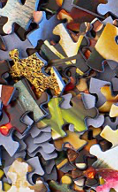Piecing Together Narratives
- vmramshur
- Jul 12, 2024
- 2 min read
Updated: Jul 13, 2024
Consider the practices of collage, quilting, assemblage, mosaic creation, and even putting together a jigsaw puzzle—not to mention reading a mystery novel. Each involves combining disparate fragments to create a cohesive and meaningful whole. This principle finds its ultimate expression in costume design and personal adornment, where every stitch, fabric selection, hue, and texture adds another layer to the unfolding narrative, enriching the characters and worlds we aim to create.
Collage and quilting, for example, bring individual elements together to form a unified work of art. In collage, pieces of paper, photographs, and other materials are arranged to tell a story or convey a theme. Similarly, quilting stitches together fabrics of various colors, patterns, and textures to create a single, coherent piece. Both require careful selection and arrangement to ensure the final piece conveys the intended message or emotion.
Mosaic creation and assemblage art also share this narrative quality. Mosaics use small pieces of tile, glass, or stone to construct images or patterns, often telling a story or depicting scenes from history or mythology. Assemblage art, involving three-dimensional works from found objects, relies on the juxtaposition of diverse materials to convey a narrative or evoke a particular atmosphere.
Even piecing together a jigsaw puzzle can be seen as a metaphor for narrative construction. Each piece, while seemingly insignificant on its own, is essential to completing the whole picture. The process mirrors how a story comes together—fragment by fragment, detail by detail.
In costume design and personal adornment, this idea of narrative construction takes on a tangible form. Every choice—whether it’s the fabric’s texture, color palette, or stitching pattern—adds depth to the character and the world being created. Costumes are not just clothing; they are a visual language that tells the audience about the character’s background, personality, and journey.
A common thread (sorry, I had to add that) runs through my teaching and artistic work: the art of piecing together narratives. This guiding theme resurfaces each time I mistakenly think I have veered off path. That new idea, technique, or activity I am excited about and think is taking me off course is actually part of the same journey.
These practices—collage, quilting, mosaic creation, assemblage, and costume design—show that narrative construction is an intricate process of piecing together diverse elements to form a unified and meaningful whole. Each new idea, technique, or activity, even when it seems like a distraction, is an integral part of this creative journey. As I prepare for my sabbatical, I am armed with metaphorical glue, thread, and an ample supply of patience. Like a detective, I hope to navigate the intersections of these artistic processes with my usual blend of curiosity and a sense of adventure.
Val












Comments